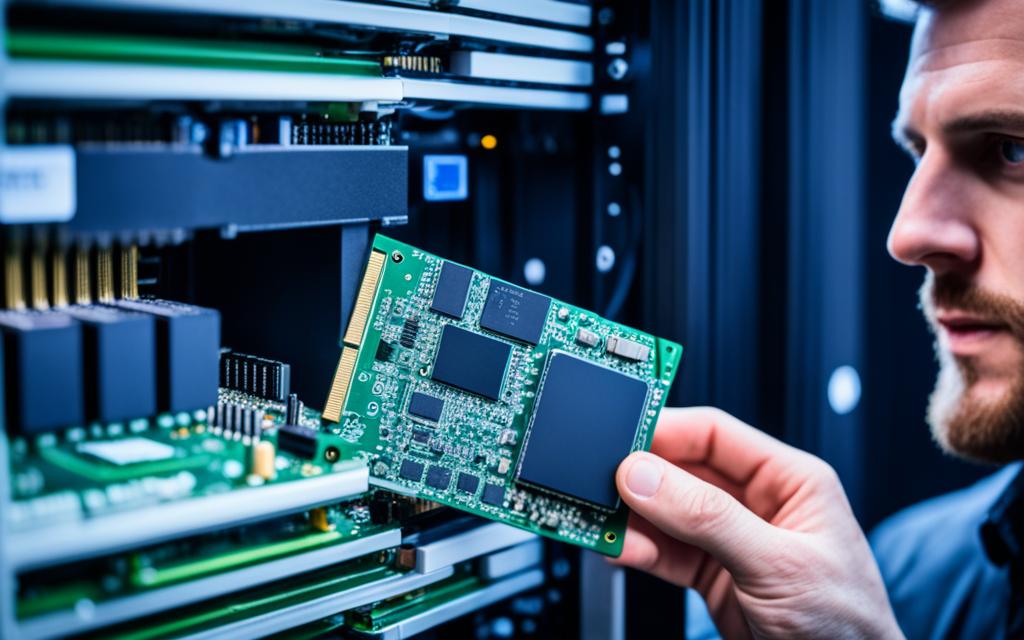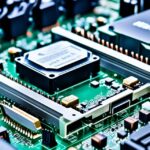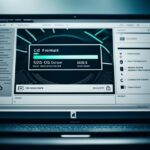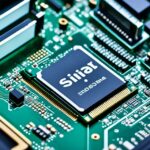Table of Contents
Finding out that your M.2 SSD isn’t showing up in the BIOS can be discouraging. This happens especially when you’re looking forward to using more storage. This piece aims to help you tackle the problem of an undetected M.2 SSD. We’re going to explore the tech behind these drives, uncover common issues, and offer clear troubleshooting steps.
Many face issues with their M.2 SSD not being detected, sharing the difficulties on forums like ASRock, Reddit, and Tom’s Hardware1. Knowing how to fix these issues is crucial. This guide provides straightforward solutions, helping you solve the common problems. If you need extra help, the EaseUS Data Recovery Service offers expert support.
Key Takeaways
- M.2 SSD not showing in BIOS can be due to misconfiguration or improper installation.
- Checking BIOS settings is essential for M.2 SSD detection.
- Driver updates may resolve conflict issues affecting drive visibility.
- Utilising data recovery software can help retrieve information from unrecognised drives.
- Step-by-step troubleshooting methods are vital for effective solutions.
Understanding M.2 SSD Technology
M.2 SSDs are at the forefront of storage tech, offering a compact, high-speed option for devices like laptops and tablets. They stand out by reaching speeds up to 2500MB/s, which boosts the performance of the system significantly23. M.2 drives connect right to the motherboard without needing cables, making the setup clean and simple.
What is an M.2 SSD?
M.2 SSDs are small solid-state drives built for high-speed mobile and compact device use. When compared to other SSD technologies, M.2 drives often come out on top because of their beneficial features.
The Advantages of M.2 SSDs Over Traditional SSDs
M.2 SSDs boast quicker read and write speeds and are smaller in size. This makes devices lighter. They also improve battery life, perfect for gaming and intensive tasks. The recent Crucial T700 PCIe Gen5 NVMe SSD is aimed at gamers who need the best performance2.
Common Causes of M.2 SSD Not Showing Up
Sometimes, an M.2 SSD might not show up in the BIOS for several reasons. A key factor is if it’s not correctly connected or installed. This means the SSD isn’t properly seated in the motherboard’s M.2 slot, making it hard to detect. Issues with BIOS configuration errors are also common. These occur if the BIOS settings for M.2 prevent the system from recognizing the drive. Lastly, driver problems can stop detection. This happens when SSD drivers are out-of-date or corrupt.
Improper Connection or Installation Issues
Correctly installing an M.2 SSD is crucial. If the connection is loose or misaligned, the SSD might not show up in the BIOS. Faulty SSDs often result from shipping or manufacturing errors. Proper installation can fix many of these issues and improve reliability.
BIOS Configuration Errors
Wrong BIOS settings can prevent M.2 SSDs from being detected. Sometimes, the M.2 port must be activated in the BIOS settings. Not doing so means the SSD remains undetected. It’s vital to check these settings to ensure smooth SSD operation with the motherboard.
Driver and Software Conflicts
Drivers issues are significant for M.2 SSD visibility. If drivers are old or damaged, the SSD may not appear in the BIOS or operating system. Keeping drivers current is essential. Updates often solve detection problems, making this a critical troubleshooting step.
| Issue | Description | Solutions |
|---|---|---|
| Improper Connection | SSD not securely attached to M.2 slot | Ensure correct installation and alignment |
| BIOS Configuration | M.2 port not enabled | Check BIOS settings for M.2 and enable |
| Driver Problems | Outdated or corrupted drivers | Update drivers regularly to avoid conflicts |
It’s vital to address these issues for M.2 SSDs to work well. A clear plan to tackle these problems can drastically reduce the annoyance of an SSD not being detected412.
Why is my M.2 SSD not showing up in BIOS?
It’s annoying when your M.2 SSD doesn’t show up in the BIOS. There are various reasons for this issue. It’s important to check your system thoroughly. Let’s look at the key steps to make sure your computer recognizes your M.2 SSD, focusing on BIOS settings first.
Checking BIOS Settings for M.2 Detection
To check if the BIOS is set up correctly, you need to access the BIOS menu. Press a function key like F2 or Delete right when you start your computer. Within the BIOS, find the storage options and check if the M.2 SSD is turned on. Mismatched settings could hide the device, making proper BIOS settings for SSD detection5 crucial. Also, switch between UEFI and Legacy modes if your motherboard has them. This could help if there are compatibility issues6.
Ensuring M.2 Slot Functionality
Checking the M.2 slot is also important. Look for any physical damage, a loose fit, or dust in the slot. A secure connection is vital for the SSD to be recognized. Correct use of the M.2 screw during installation helps a lot. Testing the M.2 SSD in another computer might also pinpoint the issue. Always perform detailed M.2 slot checks to understand better4.
Step-by-Step Troubleshooting Guide
When an M.2 SSD doesn’t show up in BIOS, a step-by-step method helps solve the issue. Start by
Configuring BIOS Settings
. Access the BIOS setup at startup. Make sure the BIOS is set to recognize the M.2 drive. Check the SATA ports and ensure the M.2 slot is turned on. A BIOS update could cause your SSD to go undetected. Review these settings7.
Then, think about
Reinstalling the M.2 SSD
. Take apart your device and take out the M.2 SSD. It’s vital to properly seat the SSD for a solid motherboard connection. This can fix any physical connection issues. Don’t ignore this step; loose connections often cause detection problems.
Next,
Updating Drivers and Windows
is crucial. Go to Device Manager for the latest M.2 SSD and chipset drivers. Make sure to keep your system up-to-date with the latest Windows driver updates. Outdated drivers can prevent SSD recognition in BIOS and operating systems8.
The last step is
Using Disk Management to Initialize the Drive
. Open Disk Management in Windows. You can initialize the drive here if it’s seen but has no drive letter. Make the needed partitions and give it a letter. This lets the operating system see and use the SSD.
Following these steps carefully can improve your success in fixing M.2 SSD problems. For deeper insights, check out detailed resources online. They offer helpful solutions for different challenges you might face while troubleshooting.
Applying a structured approach to troubleshooting M.2 SSD issues leads to better solutions.
Discover more about fixing M.2 SSD detection problems78.
Conclusion
When an M.2 SSD doesn’t show up in the BIOS, it could be down to a few issues. Think about connection mistakes, BIOS settings being off, or driver hassles. To fix these, having a good M.2 SSD troubleshooting guide is key. It’s all about double-checking BIOS settings, making sure everything is plugged in right, and getting the latest drivers. Doing these steps carefully can help solve the problem and boost your system’s power.
Taking the time to troubleshoot can not only get your SSD working again but also make your computer run better. It might mean updating your BIOS, checking connections, or following the steps we’ve mentioned. Knowing there are ways to fix the issue brings peace of mind. Using smart M.2 SSD troubleshooting tricks is a great way to keep your computer running smoothly for a long time91011.
FAQ
What should I do if my M.2 SSD is not showing up in BIOS?
Start by checking the BIOS settings. Make sure the M.2 drive is enabled. You might need to switch between UEFI and Legacy boot modes. Also, ensure the SSD is correctly installed in the M.2 slot.
How can I check if my M.2 SSD is correctly installed?
Open your device and look at the M.2 SSD’s connection to the motherboard. It should be securely in place in the M.2 slot. Make sure there’s no damage or anything blocking it.
Are there any specific BIOS settings that need to be adjusted for M.2 SSD detection?
Yes, it’s key to select and activate the M.2 drive in the BIOS. Check the SATA configuration as well to ensure it matches your drive’s requirements.
Why might my M.2 SSD not be recognised due to driver issues?
Drivers that are out of date or corrupted can stop your SSD from being seen by the system. Go to Device Manager to update or reinstall drivers if necessary.
How can Disk Management help if my M.2 SSD isn’t detected?
Disk Management lets you set up the drive, make partitions, and give it a letter. Doing this helps the operating system to recognize the SSD.
What are the performance benefits of using an M.2 SSD compared to traditional SSDs?
M.2 SSDs are faster in reading and writing data, they’re smaller which is great for portable devices, and they use less power. This means longer battery life for laptops and tablets.
Can physical damage to the M.2 slot affect SSD detection?
Yes, damage or something blocking the M.2 slot can cause issues. Always check the slot carefully before putting in a new SSD.
What brands are recommended for high-performance M.2 SSDs?
Top brands for M.2 SSDs include Crucial, Samsung, Western Digital, and Kingston. They offer fast speeds and come in various sizes to suit your needs.
How do I keep my system’s BIOS firmware up to date?
Visit your motherboard’s manufacturer’s website to download the latest BIOS update. Follow the instructions they provide carefully for a smooth update process.
Source Links
- https://www.easeus.com/data-recovery-solution/m2-ssd-not-detected-in-windows-10.html – M.2 SSD Not Showing Up in Windows 10 [Fixed 2024]
- https://www.minitool.com/data-recovery/fix-m2-ssd-not-showing-up.html – M.2 SSD Not Showing up: How to Fix It and Recover Data from It – MiniTool
- https://www.easeus.com/resource/m2-not-recognized.html – M.2 Not Recognized? Make M.2 SSD Show Up in Windows
- https://www.cgdirector.com/fix-m2-ssd-not-showing-up-in-bios/ – New M.2 SSD Not Showing Up In BIOS [How to fix]
- https://www.partitionwizard.com/partitionmanager/ssd-not-showing-up-in-bios.html – 4 Ways to Fix SSD Not Showing Up in BIOS – MiniTool Partition Wizard
- https://www.asus.com/support/faq/1044083/ – [Motherboard] Troubleshooting – Cannot find the hard disk drive or SSD(M.2) after motherboard powers on | Official Support | ASUS Global
- https://medium.com/@mciwuala/troubleshooting-guide-resolving-m-2-ssd-recognition-issues-after-a-bios-update-94caef680df7 – Troubleshooting Guide: Resolving M.2 SSD Recognition Issues After a BIOS Update
- https://www.ubackup.com/data-recovery-disk/m-2-drive-not-showing-up-1220.html – 10 Ways to Fix M.2 Drive Not Showing up in Windows 10 or 11
- https://community.acer.com/en/discussion/560583/laptop-doesnt-see-m-2-ssd-in-bios-or-anything-for-that-matter-nitro-5-an515-42 – Laptop doesn’t see M.2 SSD in Bios or anything for that matter(Nitro 5) AN515-42
- https://www.ubackup.com/data-recovery-disk/m.2-ssd-not-showing-up-windows-11-0830-rc.html – M.2 SSD Not showing up in Windows 11: How to Fix it?
- https://www.diskgenius.com/how-to/ssd-not-showing-up.php – Fixed: SSD Not Showing Up in Windows 10/8/7 | 6 Solutions








